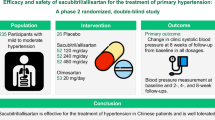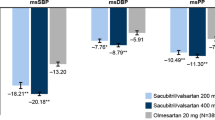Abstract
Effective antihypertensive therapy is crucial for preventing cardiovascular events; however, blood pressure (BP) control rates remain poor. The objective of this analysis was to determine the efficacy of olmesartan/amlodipine in age, severity and gender-based subgroups of patients with moderate-to-severe hypertension uncontrolled by amlodipine monotherapy. Patients with uncontrolled BP after 8 weeks' amlodipine 5 mg monotherapy (n=755) were randomized to continue amlodipine 5 mg or receive olmesartan (10–40 mg) plus amlodipine 5 mg for 8 weeks. Patients whose BP remained suboptimal were uptitrated to olmesartan/amlodipine 20/5, 40/5 or 40/10 mg. Changes in BP and numbers of controlled patients were calculated separately to assess efficacy in patients aged <65 or ⩾65 years, in those with moderate or severe hypertension, and in males and females. The antihypertensive effects of olmesartan/amlodipine were similar in patients aged <65 and ⩾65 years of age. Compared with patients with moderate hypertension at baseline, those with severe hypertension tended to show higher decreases in BP, but achieved lower goal rates despite this. Females showed larger mean reductions in diastolic (1.61 mm Hg; P=0.003) and systolic BP (1.72 mm Hg; P=0.053) than males, independent of age and dose. This gender difference appeared to be higher and more consistent across dose groups for patients <50 years of age, but the difference in the pattern between both age groups was not statistically significant (P=0.1526). These results suggest that olmesartan/amlodipine is effective and safe in a wide range of patients, regardless of age or hypertension severity. Small differences in responsiveness between females and males may exist, which require further investigation.
This is a preview of subscription content, access via your institution
Access options
Subscribe to this journal
Receive 12 digital issues and online access to articles
$119.00 per year
only $9.92 per issue
Buy this article
- Purchase on Springer Link
- Instant access to full article PDF
Prices may be subject to local taxes which are calculated during checkout



Similar content being viewed by others
References
Kearney PM, Whelton M, Reynolds K, Whelton PK, He J . Worldwide prevalence of hypertension: a systematic review. J Hypertens 2004; 22: 11–19.
Staessen JA, Li Y, Thijs L, Wang JG . Blood pressure reduction and cardiovascular prevention: an update including the 2003–2004 secondary prevention trials. Hypertens Res 2005; 28: 385–407.
Ong KL, Cheung BM, Man YB, Lau CP, Lam KS . Prevalence, awareness, treatment, and control of hypertension among United States adults 1999–2004. Hypertension 2007; 49: 69–75.
UKPDS. Tight blood pressure control and risk of macrovascular and microvascular complications in type 2 diabetes: UKPDS 38. UK Prospective Diabetes Study Group. Br Med J 1998; 317: 703–713.
Staessen JA, Gasowski J, Wang JG, Thijs L, Hond ED, Boissel J-P . Risks of untreated and treated isolated systolic hypertension in the elderly: meta-analysis of outcome trials. Lancet 2000; 355: 865–872.
Lewington S, Clarke R, Qizilbash N, Peto R, Collins R . Age-specific relevance of usual blood pressure to vascular mortality: a meta-analysis of individual data for one million adults in 61 prospective studies. Lancet 2002; 360: 1903–1913.
Chobanian AV, Bakris GL, Black HR, Cushman WC, Green LA, Izzo Jr JL et al. The Seventh Report of the Joint National Committee on Prevention, Detection, Evaluation, and Treatment of High Blood Pressure: the JNC 7 report. JAMA 2003; 289: 2560–2572.
Mancia G, De Backer G, Dominiczak A, Cifkova R, Fagard R, Germano G et al. 2007 Guidelines for the Management of Arterial Hypertension: The Task Force for the Management of Arterial Hypertension of the European Society of Hypertension (ESH) and of the European Society of Cardiology (ESC). J Hypertens 2007; 25: 1105–1187.
Wang YR, Alexander GC, Stafford RS . Outpatient hypertension treatment, treatment intensification, and control in Western Europe and the United States. Arch Intern Med 2007; 167: 141–147.
Redon J, Brunner HR, Ferri C, Hilgers KF, Kolloch R, van Montfrans G . Practical solutions to the challenges of uncontrolled hypertension: a white paper. J Hypertens 2008; 26: S1–14.
Cushman WC, Ford CE, Cutler JA, Margolis KL, Davis BR, Grimm RH et al. Success and predictors of blood pressure control in diverse North American settings: the antihypertensive and lipid-lowering treatment to prevent heart attack trial (ALLHAT). J Clin Hypertens 2002; 4: 393–404.
Law MR, Wald NJ, Morris JK, Jordan RE . Value of low dose combination treatment with blood pressure lowering drugs: analysis of 354 randomised trials. Br Med J 2003; 326: 1427.
Moser M . Rationale for combination therapy in the management of hypertension. J Clin Hypertens 2003; 5: 17–25.
Jamerson K, Weber MA, Bakris GL, Dahlof B, Pitt B, Shi V et al. Benazepril plus amlodipine or hydrochlorothiazide for hypertension in high-risk patients. N Engl J Med 2008; 359: 2417–2428.
Barrios V, Brommer P, Haag U, Calderon A, Escobar C . Olmesartan medoxomil plus amlodipine increases efficacy in patients with moderate-to-severe hypertension after monotherapy: a randomized, double-blind, parallel-group, multicentre study. Clin Drug Investig 2009; 29: 427–439.
Chrysant SG, Melino M, Karki S, Lee J, Heyrman R . The combination of olmesartan medoxomil and amlodipine besylate in controlling high blood pressure: COACH, a randomized, double-blind, placebo-controlled, 8-week factorial efficacy and safety study. Clin Ther 2008; 30: 587–604.
Volpe M, Brommer P, Haag U, Miele C . Efficacy and tolerability of olmesartan medoxomil combined with amlodipine in patients with moderate to severe hypertension after amlodipine monotherapy: a randomized, double-blind, parallel-group, multicentre study. Clin Drug Investig 2009; 29: 11–25.
Mancia G, Bombelli M, Lanzarotti A, Grassi G, Cesana GC, Zanchetti A et al. Systolic vs diastolic blood pressure control in the hypertensive patients of the PAMELA population. Pressioni Arteriose Monitorate E Loro Associazioni. Arch Intern Med 2002; 162: 582–586.
Wang TJ, Vasan RS . Epidemiology of uncontrolled hypertension in the United States. Circulation 2005; 112: 1651–1662.
Kotsis V, Stabouli S, Pitiriga V, Papamichael C, Toumanidis S, Zakopoulos N . Impact of gender on 24-h ambulatory blood pressure and target organ damage. J Hum Hypertens 2006; 20: 658–665.
Turnbull F, Woodward M, Neal B, Barzi F, Ninomiya T, Chalmers J et al. Do men and women respond differently to blood pressure-lowering treatment? Results of prospectively designed overviews of randomized trials. Eur Heart J 2008; 29: 2669–2680.
Volpe M, Miele C, Haag U . Efficacy and safety of a Stepped-Care Regimen using olmesartan medoxomil, amlodipine and hydrochlorothiazide in patients with moderate-to-severe hypertension: an Open-Label, Long-Term Study. Clin Drug Investig 2009; 29: 381–391.
Kannel WB, Gordan T . Evaluation of cardiovascular risk in the elderly: the Framingham study. Bull N Y Acad Med 1978; 54: 573–591.
Vasan RS, Beiser A, Seshadri S, Larson MG, Kannel WB, D'Agostino RB et al. Residual lifetime risk for developing hypertension in middle-aged women and men: the Framingham Heart Study. JAMA 2002; 287: 1003–1010.
Turnbull F, Neal B, Ninomiya T, Algert C, Arima H, Barzi F et al. Effects of different regimens to lower blood pressure on major cardiovascular events in older and younger adults: meta-analysis of randomised trials. Br Med J 2008; 336: 1121–1123.
Beckett NS, Peters R, Fletcher AE, Staessen JA, Liu L, Dumitrascu D et al. Treatment of hypertension in patients 80 years of age or older. N Engl J Med 2008; 358: 1887–1898.
Mourad JJ, Le Jeune S . Effective systolic blood pressure reduction with olmesartan medoxomil/amlodipine combination therapy: post hoc analysis of data from a randomized, double-blind, parallel-group, multicentre study. Clin Drug Investig 2009; 29: 419–425.
Mancia G, Grassi G . Systolic and diastolic blood pressure control in antihypertensive drug trials. J Hypertens 2002; 20: 1461–1464.
Lloyd-Jones DM, Evans JC, Larson MG, Levy D . Treatment and control of hypertension in the community: a prospective analysis. Hypertension 2002; 40: 640–646.
Weycker D, Edelsberg J, Vincze G, Levy DG, Kartashov A, Oster G . Blood pressure control in patients initiating antihypertensive therapy. Ann Pharmacother 2008; 42: 169–176.
Banegas JR, Segura J, de la Sierra A, Gorostidi M, Rodriguez-Artalejo F, Sobrino J et al. Gender differences in office and ambulatory control of hypertension. Am J Med 2008; 121: 1078–1084.
Acknowledgements
This study was funded by Daiichi Sankyo Europe, the manufacturer of olmesartan/amlodipine. Medical writing services from Lucy Ebden (inScience Communications, a Wolters Kluwer Business, Auckland, NZ) and Amy McCallum (inScience Communications, a Wolters Kluwer Business, Chester, UK) were funded by Daiichi Sankyo Europe. We thank Dr Winfried Koch of HaaPACS GmbH, Schriesheim, Germany, for assistance with the statistical analysis of data presented in this report.
Author information
Authors and Affiliations
Corresponding author
Ethics declarations
Competing interests
Professor Dr Roland Schmieder has received lecture fees and research grants from Daiichi Sankyo. He is also a member of the Advisory Board. Professor Böhm has received speaker honoraria from Daiichi Sankyo.
Rights and permissions
About this article
Cite this article
Schmieder, R., Böhm, M. Efficacy and safety of olmesartan medoxomil plus amlodipine in age, gender and hypertension severity defined subgroups of hypertensive patients. J Hum Hypertens 25, 354–363 (2011). https://doi.org/10.1038/jhh.2010.74
Received:
Revised:
Accepted:
Published:
Issue Date:
DOI: https://doi.org/10.1038/jhh.2010.74
Keywords
This article is cited by
-
Pharmacogenomics of amlodipine and hydrochlorothiazide therapy and the quest for improved control of hypertension: a mini review
Heart Failure Reviews (2019)
-
Olmesartan medoxomil: a guide to its use as monotherapy or in fixed-dose combinations with amlodipine and/or hydrochlorothiazide
Drugs & Therapy Perspectives (2016)
-
Younger Females Are at Greater Risk of Vasodilation-Related Adverse Symptoms Caused by Dihydropyridine Calcium Channel Blockers: Results of a Study of 11,918 Japanese Patients
Clinical Drug Investigation (2014)
-
Efficacy and safety of olmesartan medoxomil/amlodipine fixed-dose combination for hypertensive patients uncontrolled with monotherapy
Archives of Pharmacal Research (2014)
-
Olmesartan in the Treatment of Hypertension in Elderly Patients: a Review of the Primary Evidence
Drugs & Aging (2013)



